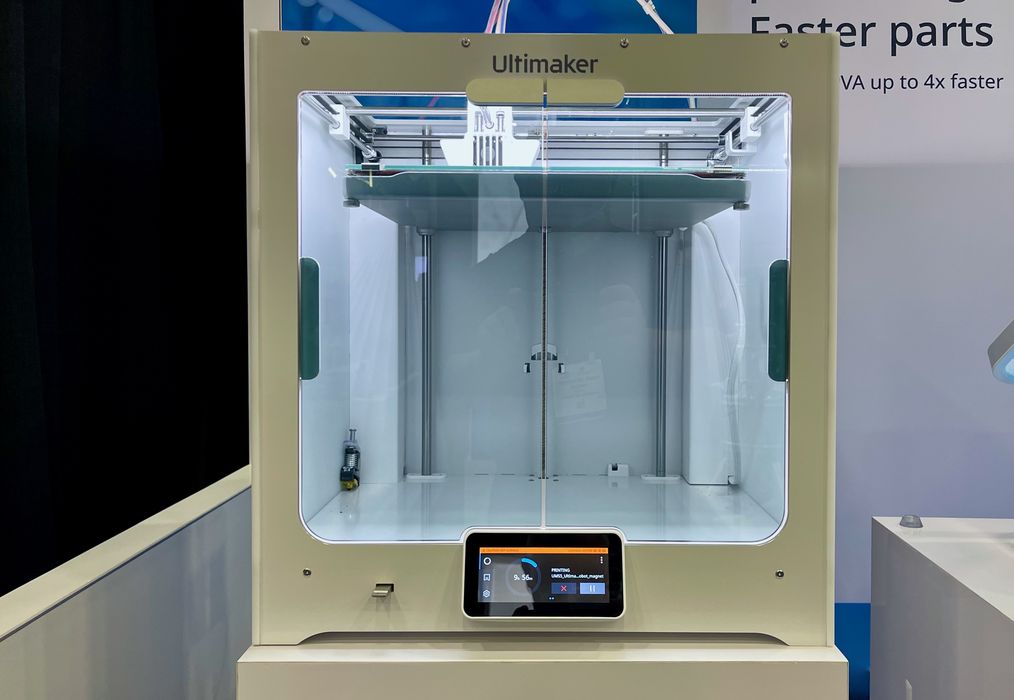
UltiMaker reacts to the high speed 3D printing explosion with speed improvements.
What’s happened? A number of 3D printer manufacturers have deployed desktop FFF 3D printers that are capable of incredible speeds. Some are 5-6X faster than typical machines, which have been running at more or less the same speed for the past ten years. This has been accomplished through the use of innovative machine firmware that provides real time compensation for the vibrations generated at high print speeds.
The company that triggered all of this was Bambu Lab, which introduced a high speed machine just over a year ago. Since then most other manufacturers have been scrambling to catch up. We’ve seen multiple announcements from several providers with newly sped up equipment.
UltiMaker has been silent on the matter of high speed 3D printing until now.
Today they announced “significant improvements” in print speed for their popular S series of professional 3D printers. The company said the print speeds are effectively doubled, while maintaining the same print quality as before.
They say the speed is obtained through the release of UltiMaker Cura 5.5, which includes “a range of optimized speed profiles”. It seems that UltiMaker’s new profiles cover a number of UltiMaker-branded materials including ABS, PLA, Tough PLA and PETG. In addition, they explained:
“Other improvements include optimized handling of material flow rates and nozzle pressures when switching between line types, ensuring no loss of print quality during transitions; smooth internal wall pathing, reducing print time and irregular movement; and reduced erratic infill motions, which smoothen the movement of the print head.”
This is a very good move by UltiMaker, as they face plenty of high speed competition these days. This will help deter buyers from moving to alternative platforms, while at the same providing existing customers with a huge boost in speed.
Remember, a 3D printer that can print twice as fast is the same as having two 3D printers. Those with larger farms of UltiMakers will suddenly find themselves with a tremendous amount of new print capacity.
What’s not said in the announcement is how, exactly, UltiMaker achieved the speed increase, aside from the use of print profiles.
The other high speed machines typically involve a firmware upgrade, accelerometer for vibration calibration, robust motion systems and print profiles.
So how is UltiMaker doing it? I can’t say for certain, but in the absence of an accelerometer, the S series cannot do the calibration on its own, but calibration factors could be hard coded as was recently done by Prusa Research on their Mini 3D printer.
There doesn’t seem to be a firmware upgrade mentioned, although it may be that UltiMaker has snuck out new features in a recent routine firmware upgrade that they perform from time to time.
Of note is that the speed increase is only 2X, whereas some of the competing high speed machines can be as high as 6X the normal speeds. This tells me that the company likely hasn’t done a firmware upgrade, and is simply tuning the print profiles very precisely to enable the machines to run at double speed. I have seen this in a couple of other machines that were touted as “high speed”, but in fact didn’t have all the high speed components listed above. Apparently UltiMaker is going that route.
While the speed increase is notable, it’s not close to the 5X speeds of many of their competitors. However, it does tell us that the company is intensely interested in print speeds. More than likely they are working right now developing a new configuration that does hit the much higher speeds, and that will probably require at least a firmware upgrade.
I’d keep a close eye on UltiMaker to see what comes next.
Via UltiMaker

While credit should be given to Bambu for commercializing high-speed printing, they freely admit they built on what had been done in the open source community with people doing high-speed printing on Vorons running Klipper, and other platforms (RatRigs, HevORTs, Vzbots, etc.).
Bambu may have been the first mover, and their launching such a strong first product certainly has lit a fire under the industry, but had they never existed the community innovations would have made their way to off-the-shelf printers in time.
So yes, Bambu triggered the wave, but they themselves were triggered by the amazing innovators in the open source world who were mostly doing it for fun and to make a contribution to their hobby.